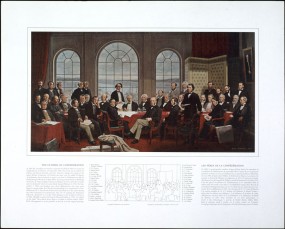Assignment 3:7 – Hyperlinking Green Grass, Running Water
Write a blog that hyper-links your research on the characters in GGRW according to the pages assigned to you. Be sure to make use of Jane Flicks’ GGRW reading notes on your reading list.
In this week’s assignment I will be attempting to analyse as well as connect various allusions and puns from a passage in Thomas King’s novel Green Grass, Running Water. I chose a passage which begins at a point that I believe addresses many of the major themes in this novel and decided to delve right into the middle of the story and chose pages 238 – 243 for my analysis. Thomas King has written his incredibly layered story in a circular fashion. I feel the theme of dichotomies has been present in many of my blog posts and it appears once more in this book, but with similar grey area in between. King intertwines the worlds of men and women, past and present, “native” and “white”, oral and literate, and most importantly of real and imaginary. The underlying idea that this is a creation story remains in these selected pages, and this passage was in the midst of an explanation. Throughout the novel, even as the many perspectives changed I always found myself waiting to get back to the unique point of view of the unknown narrative (written in first person, and if read out loud may in fact be the reader?) and Coyote. Therefore, as the narrator suggested, over the next few pages, I seated myself and listened (239).
This passage picks up with Robinson Crusoe explaining his version for a creation story that explains why there is so much water. He begins with the Thought Women and the story of the River. We also have commentary from Coyote and our Narrator, as well as Dr. Hovaugh and Babo continuing on their pursuit after the four. There were a few allusions in particular that stood out to me involving Robinson Crusuoe, the concept of the light, and the inclination towards miracles.
Robinson Crusoe:
I knew I had heard this name before I could not, however pin point why the name gave me so much discomfort. You have to understand that I am enjoying my “summer” mentality but it bugged me so much that I couldn’t quite grasp where I had heard it. I hadn’t even finished fully typing out the name of this character into google search before I was given options of “Robinson Crusoe Island”, “Robinson Crusoe 1997”, “Robinson Crusoe board game” and all of a sudden I realized that he is in fact the same figure that haunted me on my Intermediate Macro Economics exam this past winter semester. He was as an example for international trade based on the fact that he is a single individual on an island in Daniel Defoe’s 18th century novel “The Life and Adventure of Robinson Crusoe”. We used him to discuss mutual benefits under conditions of equality, reciprocity and freedom. The novel itself is a well known travel narrative and I believe King was referring to the themes in the novel regarding legitimizing colonization and its distorted representation of the “Other” in the novel. As well I believe he chose Crusoe to symbolize the unfair relationship between humans. In the novel, as Jane Flick points out Crusoe “is aided by his Man Friday, the “savage” he rescues from cannibals, and then Christianizes“. Crusoe goes on to develop a master slave type of relationship with Friday. Over the course of the novel Crusoe eventually refers to himself as “’King’ over the natives and Europeans, who are his subjects”. Defoe investigate the relationship of the colonial mind, a similar concern to Thomas King. Flick also points out that King goes on to mock his character Crusoe and even adores him in shirt that says “the one with the palm trees” (142).
There are countless allusions to Christian archetypes in this novel and it is a way for King to use humor to undermine Biblical narratives. These following two comparisons are just a couple of the examples he includes.
Light:
“As the old Indians watched, the universe gently tilted and the edge of the world danced in light” (233).
My initial thought of creation stories has to do with Christian ideals and maybe due to the influence of a common Western lens. Even though I do not practice any type of Christianity I know of the common saying “And then God said ‘Let there be light’”, or something along those lines. It was also still fresh in my mind because it was the creation story that Thomas King compared his own to during his CBC Massey Lecture. On page 230, there is a conversation regarding the turning on of a light, specifically having Coyote do so. King’s own writing may be a nod towards the biblical reference, and positioning Coyote as the creator and introducing light into the world. After the light is turned on, a star settles in the distance in the west. This star is also seen by Babo as he and Dr. Hovaugh trek towards the Canadian border. The allusion here may regard the Biblical star of Bethlehem. In a similar manner to the three wise men who searched for “the young Child”, Babo and the doctor use it as guidance to find the four natives.
Miracles:
After Babo points out the morning star that he sees in the distance, the Doctor too stares at it for some time and Babo asks “What do you think? Omen or miracle?” (238). From what I understand, the bible has many references to miracles, where by it is defined as something that cannot be explained by natural scientific laws. Instead it relates to the supernatural. Often, explanations in the New Testament are that miracles are performed by faith in God. Here again a very quick explanation for the light made by Dr Havaugh is to simply brush it off and refer to it as a miracle.
Work Cited
2003 CBC Massey Lectures, Thomas King, The Truth about Stories: A Native Narrative:http://www.cbc.ca/ideas.
Flick, Jane. “Reading Notes for Thomas King’s Green Grass, Running Water.” Canadian Literature 161/162 (1999). Web. 18 July 2016.
King, Thomas. Green Grass, Running Water. New York: Bantam Books, 1994. Prin
“Robinson Crusoe and the Secret of Primitive Accumulation.” Monthly Review. N.p., 01 Sept. 2011. Web. 25 July 2016
“What Does the Bible Say About Miracles?” Christian Courier. N.p., n.d. Web. 25 July 2016.
Wikipedia. Wikimedia Foundation, n.d. Web. 24 July 2016.








